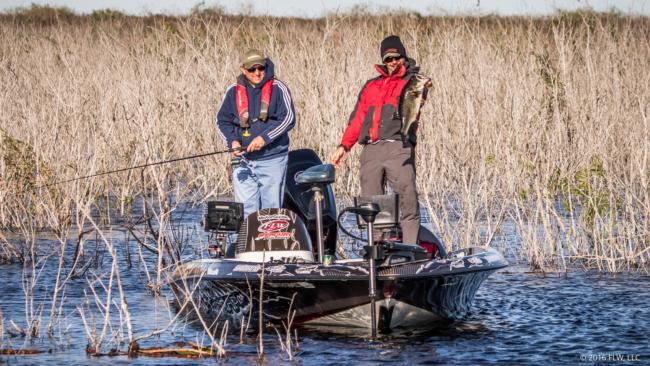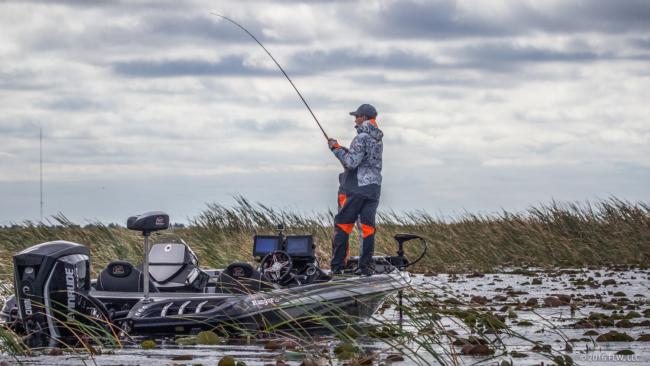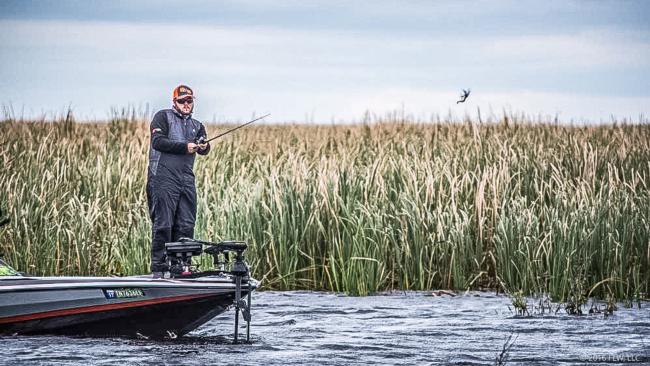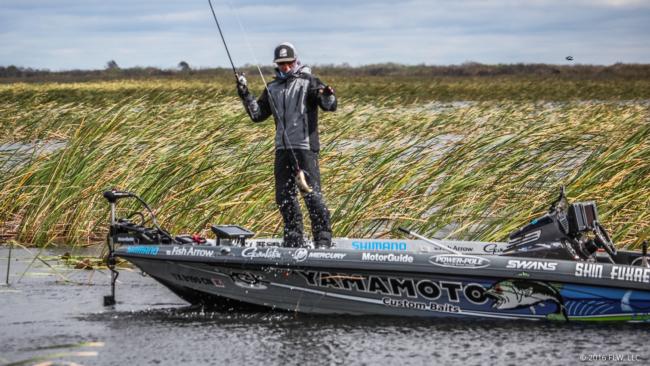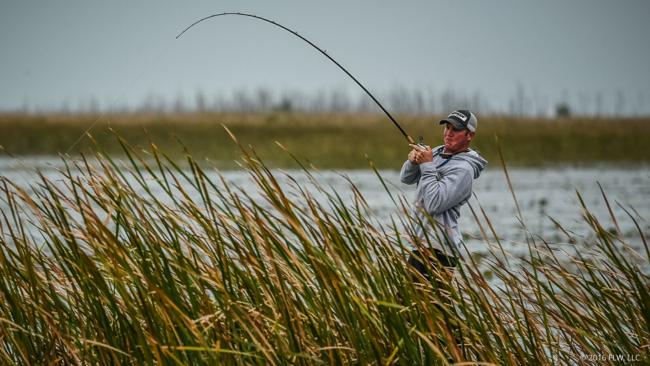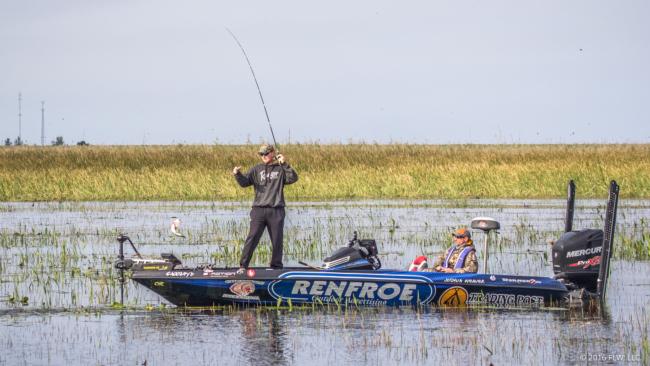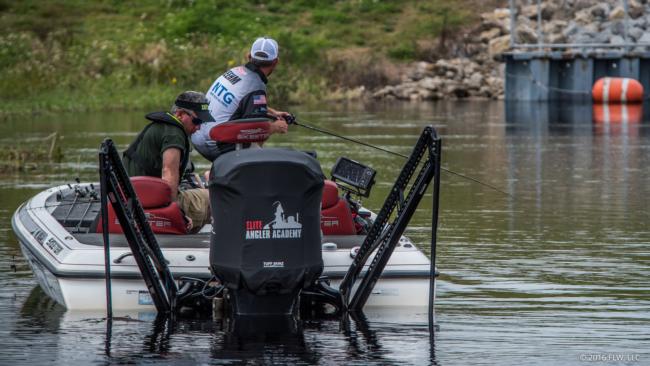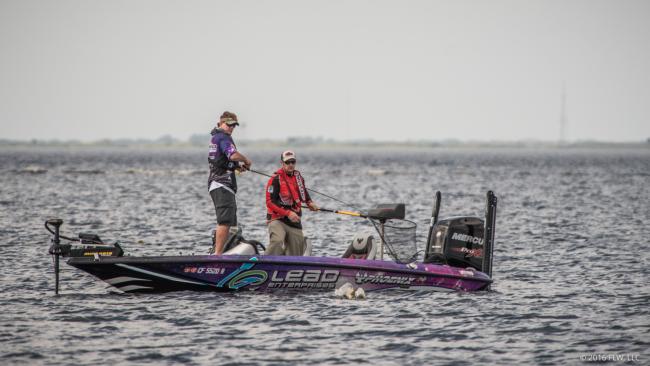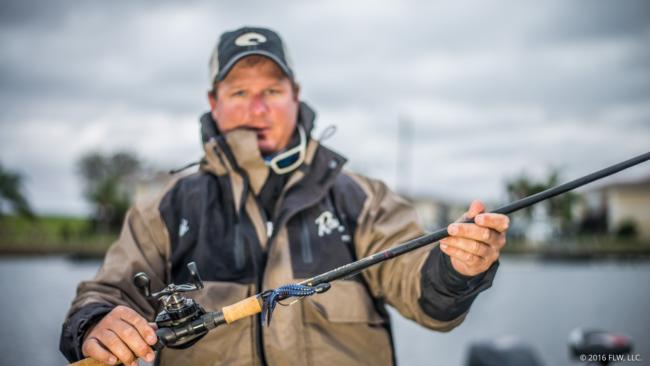Top 10 Patterns from Lake Okeechobee
How the highest finishers handled Florida’s wild weather swings
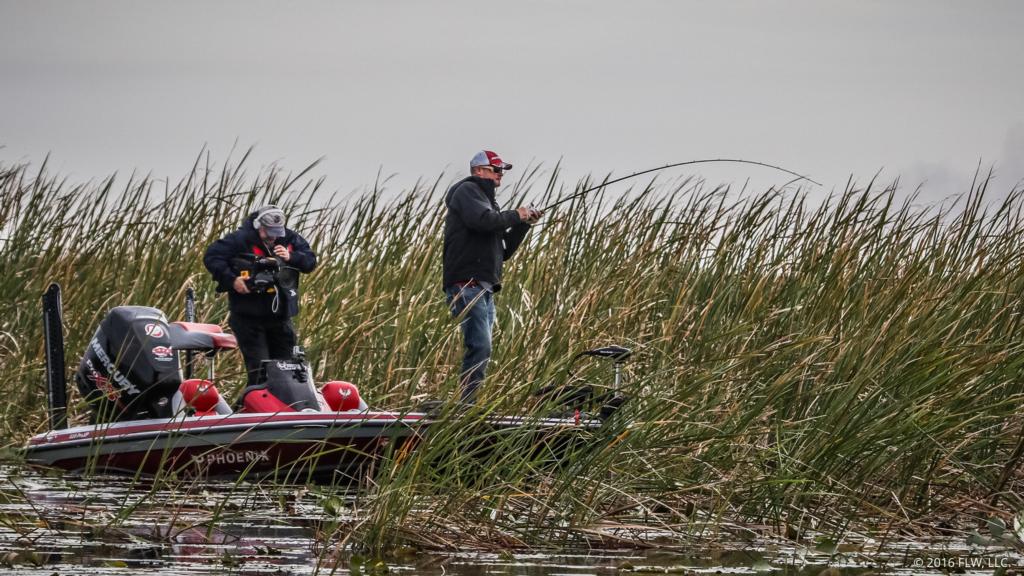
Oklahoma’s Bradley Hallman sewed up his first Walmart FLW Tour victory at the season-opener on Lake Okeechobee presented by Ranger Boats by pitching and punching reed heads in the South Bay area with a Reaction Innovations Sweet Beaver. Hallman stuck with his program despite up-and-down air temperatures, high winds and all the curveballs Mother Nature could throw at him.
Hallman dominated the first two days with more than 50 pounds of bass, then went into survival mode after that and brought in only six keepers the last two days. Still, his lead was so great after day three that Hallman could’ve won the tournament without even fishing on Sunday.
Read more about his winning pattern here.
Then check out how the rest of the top 10 got it done.
2. Alex Davis found beds in flooded bushes
Alex Davis, a well-known guide from Lake Guntersville, scored a top 10 in the season-opener to get his Tour season off on the right foot. Davis’ four-day total was 56 pounds, 4 ounces.
Davis found a mother lode of spawning bass on the Big O in a small clear-water pocket just several hundred yards off the main lake. The area was the size of two or three bass boats and featured flooded trees and bare bushes – quite an anomaly among Okeechobee’s thousands of acres of green vegetation. According to Davis the area featured about 60 or 70 flooded bushes and small trees, and every one of the bushes had a bed at the base of it.
“It was all hard bottom in there,” Davis says. “They were bedding in there like you see bream or shellcracker bed with beds all crammed in there next to each other – dozens and dozens of beds.”
Over the first two days, Davis hauled almost 42 pounds of bass out of the trees, which put him behind Hallman going into day three. But on day three the Alabama pro’s gold mine area fizzled out, and he had to resort to fishing hayfields for buck bass just to try and get a limit.
When fishing the bed-laden woody cover, he used a Jackall Flick Shake 6.8 (Junebug) worm topped with either a 1/4- or 3/8-ounce weight. He pinned the worm on a 5/0 Gamakatsu EWG Superline hook tied to 80-pound-test PowerPro Maxcuatro braid.
“Getting a bite wasn’t the hard part,” Davis says. “If I could just get the bait anywhere back in that flooded jungle, one would bite it. But getting them out was a different story. Winching them out of there was pure chaos. I lost a couple that way, but it sure was fun while it lasted.”
3. Chris Johnston flipped and fished a swim jig
FLW Tour rookie Chris Johnston made his 1,500-mile journey from Ontario to Lake Okeechobee worth it with a third-place finish in the Tour season-opener. He weighed in 56 pounds, 3 ounces.
Johnston found a two-part program of winding and punching in South Bay to be his ticket to the top 10. When winding, Johnston relied on a 1/2-ounce swim jig trailed with a Reaction Innovations Skinny Dipper, both in black and blue. As things got tougher toward the end of the week, he leaned more toward the punching game with a Reaction Innovations Sweet Beaver.
“I had a variety of punching weight sizes tied on, from 3/4 ounce to 1 ounce to 1 1/2 ounce,” Johnston says. “I changed up based on how thick the blown-in prop chop was in the reed heads. By the last day, there was a lot of chopped-up stuff blown tight into the heads, so I went to the 1 1/2 ounce.”
4. Michael Neal went north, swam a jig
While most anglers in the top 10 made the cut fishing in the southern portion of the lake, Michael Neal bucked the trend by heading north and fishing on either side of the Kissimmee River to sack up 55 pounds, 15 ounces.
“I fished up there the first time I came here and did well,” Neal says. “I like it because it’s protected from the north wind and has a large mix of vegetation: Kissimmee grass, hydrilla, gator grass, buggy whips, reeds, arrowheads. It offers a little bit of everything.”
To probe the variety of vegetation, Neal relied primarily on one lure: a 3/8-ounce TrueSouth Custom Lures swim jig (black/blue) teamed with a Big Bite Baits 4 1/4-inch Cane Thumper (hematoma).
He threw the swim jig on a 6.5:1 Ardent reel, 60-pound-test Sunline FX2 braid and a Cashion Rods ChatterBait/swimbait rod that he designed.
“When it got windy, I went to a 1/2-ounce version of the swim jig,” he says. “They key was to pole down and thoroughly cover the best-looking places. Sometimes I’d fan-cast one area for several minutes before moving on.”
5. Shin Fukae shared water with Hallman
With a top 10 secured at the Okeechobee opener, Shin Fukae is solidly out of the blocks in pursuit of another FLW Tour Angler of the Year title.
Fukae shared water with tournament winner Bradley Hallman from day one. But Fukae says he did not commit to punching every hour of every day like Hallman did. At times Fukae strayed away from the reed heads to throw a Yamamoto Senko with a 1/4-ounce weight into vegetation holes. The technique provided more bites, but lower quality when compared to punching the reed heads. Fukae’s tournament total was 52 pounds, 9 ounces.
When he did punch, Fukae used a Yamamoto Flappin’ Hog (black blue flake) teamed with a 1 1/2-ounce Fish Arrow tungsten weight, a 4/0 Gamakatsu Super Heavy Cover Flippin’ Hook and a punch skirt (black/blue) tied to 60-pound-test YGK braided line.
His rod and reel selection for his punching game included a G. Loomis 7-foot, 11-inch flipping stick teamed with Shimano Metanium reels with an 8.5:1 reel ratio.
6. Brandon McMillan flipped, wound his swim jig
Local favorite Brandon McMillan got off to a great start with a 22-pound, 8-ounce catch the first day, but he scrambled after that to stay in the top 10 and ended up sixth with 51 pounds, 4 ounces.
McMillan spent most of his time in South Bay winding his namesake 4X4 swim jig tipped with a Reaction Innovations Little Dipper and punching reed heads with a Zoom Z-Hog Jr.
His flipping setup included a 7-foot, 11-inch G. Loomis heavy-action flipping stick, a Shimano Core reel and 60-pound-test Gamma braid. He had four to five of the flipping setups on his deck at all times, but each one had a different size weight.
“I had from 3/4-ounce to 2-ounce Elite Tungsten weights tied on,” McMillan reveals. “Which one I pitched at any given time totally depended on how thick or compressed [from wind] the mats were. If it was sparse or loose, I’d go with 3/4 ounce. If it was thick and tightly compacted, I might have had to go to a 1 1/2 or 2 ounce to get through it. With so much variance in the thickness of that stuff out there, it’s nice to be able to change at will just by picking up another rod.”
7. Joshua Weaver relied on one-two punch of winding and pitching
Rookie Joshua Weaver scored a top 10 in his first FLW Tour event from the front of the boat with a four-day catch that weighed 50 pounds, 5 ounces.
Like others in the top 10, Weaver spent the week winding and pitching in South Bay. But when pitching, Weaver was not necessarily punching reed heads. Rather, he was pitching to holes in the vegetation.
Weaver’s casting and winding rig consisted of a McMillan’s secret-colored Brandon McMillan Signature Series 4X4 Swim Jig teamed with a Reaction Innovations Skinny Dipper (sungill). His pitching rig included a Zoom UV Speed Craw (blueberry) on a 1/2-ounce tungsten weight. He had to go to a 3/4-ounce weight on the final day to combat the wind. When winding or flipping, Weaver used 65-pound-test braided line.
8. Clark Reehm uncovered an unusual current-driven feeding pattern
Texas pro Clark Reehm by far had the most unconventional pattern going at Lake Okeechobee to earn his eighth-place finish with 48 pounds, 8 ounces.
Reehm figured out a way to navigate his boat through three miles of Okeechobee marsh to get to one small canal discharge located on the north side of the lake. If the lake had not been so high (16 feet above sea level) he would not have been able to access the discharge.
“I was focusing on feeding fish, not spawning fish,” Reehm reveals. “With all this crazy weather affecting the spawn, I wanted to find something more stable. So I used my mapping to figure out how to get to this canal discharge, which was creating current.”
Reehm notes that the real sweet spot – the deep hole under the discharge – was actually off limits due to a restricted area just below the discharge. But, he could still fish the outer lip of the hole where current was pouring out.
“These were not great big fish, but they were 2- to 4-pounders. I would catch so many of them that I could play the numbers game and cull up ounces at a time to get beyond that 13-pound mark the first two days, which got me in the cut,” he says.
Reehm’s key bait for the discharge current was a Megabass Vision 110 suspending jerkbait and a Texas-rigged Zoom Speed Craw with a 1/4-ounce weight.
9. Charlie Weyer went old school with a worm
Punching reed heads was not the only pattern working at Lake Okeechobee last week as Charlie Weyer proved that the old tried-and-true method of casting worms into holes in the vegetation is still alive and well.
Weyer found an area loaded with beds along the lake’s West Wall during practice. On day one he brought in 11 pounds, 4 ounces, but when the wind blew on day two, he blasted 23 pounds, 2 ounces.
“I think I just fished too fast through those beds the first day and only caught bucks,” Weyer says of the vast difference in the two days. “On the second day, that wind really forced me to pole down and work each hole in the vegetation thoroughly, and that’s when I caught the females.”
For much of the week Weyer fished the holes with a Yamamoto Senko (black/blue and watermelon red) rigged on a Trokar 5/0 offset hook with a 3/16-ounce weight (3/8-ounce when it got windy), all tied to 20-pound-test Seaguar Tatsu fluorocarbon.
10. Billy Shelton junk-fished in South Bay
Billy Shelton junk-fished the South Bay area by casting and winding over pads and hay and punching reed heads.
His preferred winding rig was a Zoom Mag Speed Worm (junebug) rigged with 3/16-, 1/4- and 1/2-ounce weights for different wind conditions, and all fished on 50-pound-test braid.
When punching, he opted for a Reaction Innovations Sweet Beaver (black/blue) with a 1- to 1 1/2-ounce tungsten weight, depending on wind. He punched with 65-pound-test braid.
Shelton also caught a few on a Zoom Magnum Super Fluke (watermelon red) cast into holes in the vegetation.
